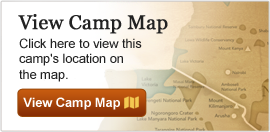Jack’s Camp
premier Camp | Makgadikgadi / Kalahari, Botswana
| Read Reviews | Write a Review
While on a trapping expedition in the Makgadikgadi Pans of Botswana during the 1960s, Jack Bousfield stumbled upon a site that so captured his imagination that he set up camp under an acacia tree with the unshakeable expectation that others would feel the same way. The choice of such a striking location rests in large part on his original taste for the primal beauty of a forgotten Africa.

Our Expert Says
One of the greatest moments of all my safaris took place at Jack’s Camp, though I cannot tell you what it is, as Jack’s is nothing if not a surprise. All I can say is that if you are an enthusiast for observing—and immersing yourself in—the most unique side of Africa, at some point in your life this is a place you should visit!
– Ben Bressler

The Camp
Location: Eastern Kalahari Desert, Botswana
Number of Tents: 9
Jack’s Camp is an oasis of style and comfort in the midst of Botswana’s Kalahari Desert. A luxurious tented camp with a private museum, pool pavilion and decadent tea tent, Jack’s was reimagined in 2003, taking on an even more elegant, yet traditional, East African 1940s-safari style. Nine large and very stylish canvas tents with en suite bathrooms and indoor and outdoor showers (for those who want to feel the Kalahari breeze on their skin) have been expertly fashioned in classical style and are set into a palm grove creating a supremely comfortable and luxuriously appointed safari camp in what can be the starkest of environments. Persian rugs underfoot and cool cotton sheets form a striking contrast with the rugged wilderness viewed from the comfort of individual verandas. Delectable cuisine with china and crystal service is featured in the ornate Bedouin-style dining room.

Facilities & Amenities
- En suite bathroom with indoor/outdoor showers
- Shampoo, soap, lotion and insect repellent
- Hair dryer
- Cooling system over the bed
- 220v charging outlets in room
- Private plunge pools
- Central swimming pool pavillion
- Laundry included
- Local drinks included (house alcoholic and non-alcoholic drinks)
- No telephone, Internet or cellular coverage

Wildlife Viewing & Activities
During the wet season the Kalahari landscape transforms as clouds of flamingo and other migratory birds descend from the heavens to decorate the watery grasslands. Herds of zebra and wildebeest materialize, drawn by the lush grass, and for several months, the desert is teeming with plains animals and their predators. Guides at Jack's Camp are an erudite breed; they are often graduate students who combine research with guiding, teaming up with a small group of Zu/’hoasi Bushmen to lead morning walking safaris and game drives. Other options include venturing out on 4x4 quad bikes exploring archaeological sites, which periodically unearth never before documented fossil beds of extinct giant zebra and hippo. A safari to Jack's Camp is a complete desert experience, focusing on species unique to the area such as aardvark, gemsbok, springbok and the rare and elusive brown hyena and being able to walk through the Kalahari with a gang of habituated but wild meerkats!
Antelope tend to migrate into the central and eastern Kalahari deserts following water and grasses between December and April, often followed by predators. During the driest months from June to October, the landscape hosts fewer large mammals but the most commonly viewed animals at this time may be gemsbok, springbok, red hartebeest and steenbok and a number of other small mammals, birds and reptiles. Exact sightings will depend on weather and wildlife movements.
| Country | Park/Reserve |
Cheetah
|
Gemsbok / Oryx
|
Lion
|
Wildebeest
|
Zebra
|
|
|---|---|---|---|---|---|---|---|
| Botswana | Makgadikgadi / Kalahari |
| Usually viewed | Frequently viewed | Occasionally viewed | Sporadically viewed | Rarely to never viewed |
Climate
| Month | Max | Min | Rainfall |
|---|---|---|---|
| January | 97° F | 62° F | 3.5 in |
| 36° C | 16° C | 89 mm | |
| February | 90° F | 61° F | 2.76 in |
| 32° C | 16° C | 70 mm | |
| March | 90° F | 54° F | 2.01 in |
| 32° C | 12° C | 51 mm | |
| April | 87° F | 51° F | 1.1 in |
| 30° C | 10° C | 28 mm | |
| May | 85° F | 45° F | 0.16 in |
| 29° C | 7° C | 4 mm | |
| June | 83° F | 37° F | 0.04 in |
| 28° C | 2° C | 1 mm | |
| July | 77° F | 31° F | 0.0 in |
| 25° C | -1° C | 0 mm | |
| August | 83° F | 31° F | 0.0 in |
| 28° C | -1° C | 0 mm | |
| September | 95° F | 45° F | 0.16 in |
| 35° C | 7° C | 4 mm | |
| October | 96° F | 54° F | 0.75 in |
| 35° C | 12° C | 19 mm | |
| November | 99° F | 56° F | 1.65 in |
| 37° C | 13° C | 42 mm | |
| December | 101° F | 64° F | 2.4 in |
| 38° C | 17° C | 61 mm |

Conservation
Several of Jack’s Camp’s guides are committed champions of wildlife indigenous to the Kalahari. In 2000, Glyn Maude set up the Makgadikgadi brown hyena project which has logged thousands of hours of observations of brown hyena, tracked and collected data from radio-collared hyena and has distributed this information to the relevant wildlife management and conservation bodies. His work is changing people’s unjustified negative perceptions towards this gentle scavenger. Graham McCulloch became fascinated with the fact that Makgadikgadi’s wetland system is one of the most important breeding sites for flamingo in Africa. He began his field research in 1998, committed to understanding how and why this wetland is so important for flamingo and other important water birds. He is currently taking his research a step forward by setting up a long term monitoring program through a conservation group. The aim is to create stakeholder participation in the long-term conservation of the wetlands through training and promoting improved local livelihoods.
Reviews for Jack’s Camp
Review Jack’s Camp















































